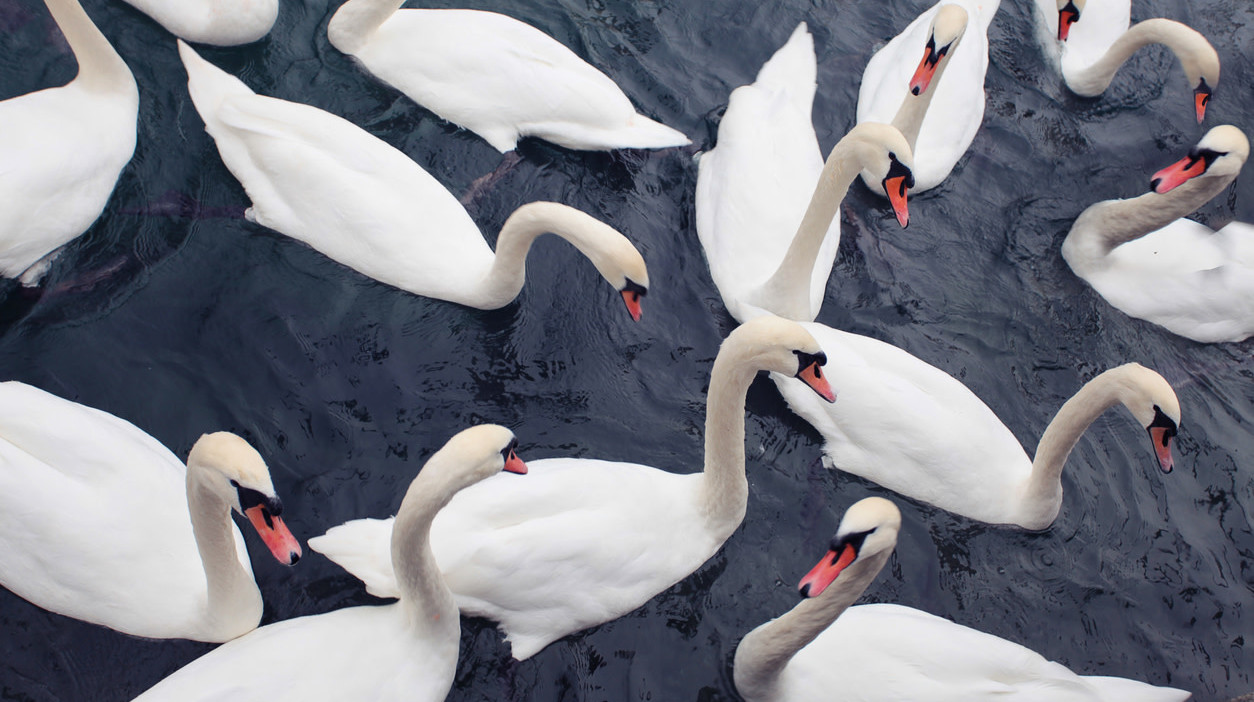Why Don't We Eat Swans?
We eat chickens. We eat ducks. We eat Thanksgiving turkeys and Christmas geese. Hell, we can even eat peacock, if we're so inclined. Yet we do not eat swans, despite the fact that they are assholes. Ordinarily I enjoy birds— even the ones that people hate for no good reason, like pigeons and seagulls. I'm even cool with geese despite the fact I was once attacked by three of them after my husband threw a bunch of crumbled Cheez-Its in my hair. But swans? Swans are dicks who will lure you in with their elegance and beauty, and then they will attack you. Swans deserve to be eaten, so why don't we do it?
The most common explanation I have found: As a former British colony, America has taken many of our societal cues from the Crown and, as popular law goes in the U.K., a 15th-century royal decree made every one of the nation's swans property of the reigning monarch. There is a grain of truth to this theory: Swans are so delicious that, during the Middle Ages, they were commonly found on aristocratic plates and were a popular centerpiece at royal banquets. In 1482, Edward IV of the House of York approved The Act of Swans, making all the swans of England property of not only the royal family, but of all landowners and nobility:
"Where as well our said Sovereign Lord the King, as other Lords, Knights, Esquires and other noble men of this noble realm of England, have been heretofore greatly stored of ... swans in divers parts of this Realm.... Until of late, ... divers keepers of swans ... have stolen cygnets and put upon them their own mark by which unlawful means the substance of the swans be in the hands and possession of yeomen and husbandmen and other persons of little reputation.
Wherefore it is ordained, established and enacted by our said Sovereign Lord the King ... that no person, of what estate, degree or condition he be ..., shall have or possess any such (swans) of his own or any other to this use shall have or possess any such (swans) except he have land ... of the estate of freehold to the yearly value of five marks above all yearly charges. And if it happened any person or persons not having any possession of lands ... to the said yearly value, ... to have or possess any such (swans)..., and it shall be lawful to any of the King's subjects, having lands ... to the said value, to seize the said swans as forfeit; whereof the King shall have one half and he that shall seize, the other half.
From that point on, all swans found in the wild were marked by the royal Swan Master, who would etch a symbol on the swans' beaks to denote ownership. The finest swans were claimed as property of the Crown; the rest were divvied up between noble families, wealthy landowners, and London's livery companies, such as the vinters and the dyers. Anyone caught hunting or eating a swan that was not a member of the upper class was charged with theft, a practice that still occurs (though today these charges relate more to wildlife conservation than treason against the Crown).
Swans were never illegal to eat—they were just illegal for poor people to eat. Think of swans like a lobsters, truffles, or Kobe beef, a delicious indulgence that eventually became the domain of the rich and powerful. There is a wealth of swan cookery info in 1660's The Accomplisht Cook by Robert May—the greatest "celebrity chef" of the Restoration Era—an extremely rare book that had no more than 200 printings in the 17th century. Moving to the 18th century, recipes exist in 1737's The Whole Duty of a Woman: Or, an infallible guide to the fair sex. Containing, rules, directions, and observations, for their conduct and behaviour through all ages and circumstances of life, as virgins, wives, or widows, a book that appears to be written for upwardly mobile women who would not have had servants, but were perhaps married (or hoped to be married) to wealthy merchants and captains of industry.
Over time, the illegal-for-most nature of eating swans began to be conflated with the idea that swans were inedible. Tastes began to change in the upper classes as well, as the swan was becoming more associated with grace and beauty than good eating. Another potential theory for the gradual shift from eating swans: art, particularly depictions of the Greek myth Leda and the Swan. Outside of Greece and Italy, this erotic myth was essentially unknown in Northern Europe and much of France. Then came this incredibly NSFW Rococo painting by Parisian artist Francois Boucher, as well as other artistic and literary depictions of swans that inexorably tied them to feminine beauty and themes both romantic and sexual. This is still a popular artistic motif, one that was memorably the center of a 2012 police-enforced act of censorship over concerns that the artwork "condoned beastiality."
Just as we don't eat dogs and horses because they're cute, we don't eat swans because they're sexy and sophisticated. They're associated with royalty and reverence, and they are—thanks to the ancient Greeks—mildly erotic. It's just generally understood that swans are not food birds, and no one really ever thinks to question that policy because none of them have ever had their hot dog stolen by a swan who laughed at them as he ate it. And so, swans will continue to dodge the butcher's blade, even if they are assholes.
